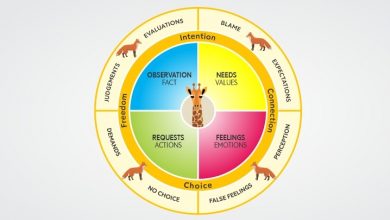Timed Sharing
Timed sharing is a principle and method to give every participant an equal opportunity to share in a session.

Why did I choose this tool?
Often what happens in a training is that the loudest, most quick voice gets the attention. This means that the people who process information a little more slowly or have a little more fear of speaking don’t get a chance to contribute. The conversation then becomes unbalanced, with only a few people actively participating and the others not.
Another thing that happens is that some people will go on and on, speaking without realizing how much time they are using. This can be really difficult as a trainer to interrupt, because we want them to contribute and yet we feel the tension in the group rising.
I have found the concept of timed sharing to help me manage many of these types of conversations. It gives me a sense of relief knowing that I don’t have to interrupt people and that people know what the rules are. It also helps me feel proud that I’m giving space to speak for the people who don’t normally take the space.
How does this apply to being a trainer?
As a trainer, I believe we must give an opportunity for everyone to learn and recognize that people learn and contribute at different speeds and in different contexts. I see it as an important skill to be able to not only recognize when there is a part of the group that doesn’t have or isn’t taking the opportunity to speak, but to create the structure to give them the space to contribute. While there are many ways to balance the conversation, timed sharing helps give the time and space for people to engage. It takes away the pressure of having to know when to interrupt (as that timing can vary based on cultures) and can give participants more clear expectations on how to engage.
Content
Timed sharing is the idea of giving participants an opportunity to share for X amount of time and using a clock to determine when their time has finished and then letting the next person share. This can be done in a large group but I find that it typically works better in small groups, where you go around in a circle and let each person have an opportunity to speak.
As mentioned above, this helps bring a diverse set of voices to the table—it gives a fair amount of time to each person so that everyone can contribute evenly.
Different ways to do timed sharing
It can be done in different ways regarding how to measure the time:
- We can use a countdown timer.
- With a countdown timer, we set the number of minutes we want to give to each person, for example, 2 minutes per person. When the person begins to speak, we start the countdown. When the time finishes, we have the option of telling the person that the time finished, which can be difficult to interrupt them but is seen as a more smooth option than the second one, which is to have the alarm on the timer ring. When the alarm rings, it can be jarring to some and yet it makes it so that we don’t have to interrupt people and everyone is aware the time has ended. People normally will wrap up what they’ve said after they hear the beeping, and this is the method I prefer.
2. We can use a count-up (stopwatch) timer.
- With a count-up or stopwatch timer, we can let it go up until the number of minutes we have given them. With time finishes for one person, we have to let people know that the time has stopped. If we have a watch or phone that beeps when we stop the stopwatch timer, then we can use that to signal that time has ended. If we don’t, then we have to interrupt the person and let them know. I find this method helpful if we’re giving space to two or more people to contribute and we want to have more flexibility in exactly how much time we give to each person. It allows us to sometimes give one person a little extra time and a little less to another, which can be helpful if we’re trying to maintain the flow of the event.
3. We can use the time on the clock.
- With using the clock, we let people know that they start and finish at certain times. For example, if we want people to have 5 minutes each, then we could say that the first person starts at 11:00 and has to finish by 11:05, and then the next person goes from 11:05 to 11:10, etc. We could use a public clock that everyone can see or just make sure that everyone has their watches synchronized. When the time finishes, we can tell people “OK, make sure you switch,” or something else to remind them that time has expired. This can be helpful when we have multiple groups running at the same time and can’t coordinate their times ourselves.
4. We can use a distance instead of a time.
- With using a distance instead of a time, we let people have a physical/spatial reference for when they start and finish an activity. For example, if we have everyone sitting in a circle, we can have one person stand up, walk around the circle one full time, and then sit down. While that person is walking around the circle, s/he could be the only one speaking. After that, the next person stands up, walks around the circle, and speaks until s/he sits down. This gives everyone a reference for when someone starts and stops, and also gives some flexibility in how quickly/slowly someone goes.
5. Other ways
- I’m sure there are other ways we can do this. We can experiment ourselves to see if there are ways we can create to manage the amount of time that someone shares. We could use an hourglass timer, or maybe in some cases people could count out loud to a certain number (if it’s a nonverbal sharing exercise), or something else.
What are some challenges that can arise with timed sharing?
Not everyone will love the timed sharing methods. Some people may feel frustrated by having too little time, or they may feel frustrated by having too much time. Some people may feel frustrated that the process is so structured, and others may be frustrated that you’re not enforcing the enough.
How to resolve these challenges?
One thing we can do is to remind the participants that we’re using this method so that people from diverse backgrounds can more easily participate. Also, we can remind them that inherent to working with diversity is the fact that not everyone will love every method that we use—some will love it, some will hate it, and some will be indifferent to it. We can also ask for their permission, flexibility, and understanding as we use this method for the exercise.
Some other benefits of timed sharing
Beyond giving a fair amount of time to each participant to share, timed sharing can have other benefits:
- Setting a rhythm/tempo for the group
- Keeping the rest of your workshop/training on time
- Signaling to the group that you’re willing to use different methods to give voice to different people
- Relieving the stress from other trainers who think you may go over time or let someone overrun the conversation
Reflection Questions:
- How do you feel when you use the countdown timer?
- How do you feel when you use the count-up timer?
- How do you feel when you use the clock (hour/minute)?
- What are some challenges you have in this process?
- What are some things you like about this process?
- How do you feel when you think about being a participant and having to fight to get time to speak?
- How do you feel when you think about being a participant and being limited in the amount of time you can speak?
- What are some other methods you can use to give participants a fair amount of time to share?
Exercises:
How to apply it in everyday life
- Try this with your significant other. Ask a question and then give each other X minutes to respond, where one person speaks and the other person listens.
- Try this with your family at the dinner table. You can ask a question or have a general theme or even have it be open-ended, just giving each person a chance to talk.
- Try this at a meeting with your organization. If you have a meeting of 5 people, take a portion of the meeting, maybe 10 minutes, and give each person 2 minutes to speak about what they think about a certain decision that has to be made.





